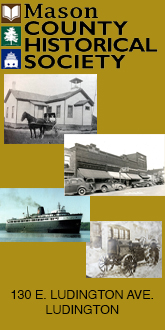
The S.S. Milwaukee
Great Lakes History Log is presented by Filer Credit Union with offices in Manistee, Ludington, East Lake, and Bear Lake and the Mason County Historical Society, which operates the Port of Ludington Maritime Museum, Historic White Pine Village and the Rose Hawley Archives in downtown Ludington.
Part 2: S.S. Milwaukee
By Rob Alway, Editor-in-Chief
The last four months of 1929 were a deadly time for Lake Michigan shipping. At least four shipwrecks claimed the lives of over 100 people. This series discusses each of those wrecks and makes some comparisons to why some resulted in total losses while others had much fewer lives lost.
The ships lost included the S.S. Andaste (Sept. 9), the S.S. Milwaukee (Oct. 22), the S.S. Wisconsin (Oct. 29), and the S.S. Senator (Oct. 31). Of those five wrecks, two of them resulted in total lives lost. Neither of those two ships, the Andaste and the Milwaukee, were equipped with wireless radio.
Read about the sinking of the Andaste in part 1 of this series here.
Read about the sinking of the Wisconsin in part 3 of this series here.
The loss of the S.S. Milwaukee on Oct. 22, 1929 was the worst car ferry disaster in the history of the Great Lakes. All on the ship, an estimated 43 to 56, were lost. It was the third and last car ferry to be lost. Interestingly, all three of the car ferry disasters were of the same design and built by the same ship yard within three years of each other.
The first ship lost was the Marquette & Bessemer No. 2 on Dec. 7, 1909 in Lake Erie with all hands, 30 to 32, lost. The second ship lost was the Pere Marquette 18 on Sept. 9, 1910 in Lake Michigan with 29 lives lost and 33 saved.

S.S. Milwaukee, foreground, and sister ship Grand Rapids.
All three ships were designed by naval architect Robert Logan and were built by American Shipbuilding Co. in Cleveland. PM 18, Hull No. 412, was built in 1902. The Milwaukee, built as Manistique Marquette and Northern 1, was built in 1903 as Hull No. 413. The M&B No. 2, Hull No. 428, was built in 1905. All were 338 feet long.
The Manistique Marquette and Northern 1 was built for the Manistique Marquette and Northern Railroad, and operated from Northport to Manistique. It was commonly called the Manistique. In 1904 the railroad defaulted on an interest payment and went bankrupt. It then came under control of the Pere Marquette Railway which shut down the Northport dock and moved the ship to Ludington where it then operated from Ludington to Manistique, a 138 mile, 11 hour trip. The ship operated Tuesdays, Thursdays, and Saturdays from Ludington for two years.
Following the PM’s bankruptcy in 1905, the ship was returned to its original route, in 1906, between Northport and Manistique. In 1908, the MM&N Railroad was succeeded by the Manistique and Northern Railroad, which was partially owned by the Ann Arbor Railroad. The Ann Arbor had been running its Frankfort-based carferries to Manistique since 1898 and no longer had a need for a Northport dock.

Manistique Marquette and Northern 1
The Manistique was sold to the Grand Trunk in 1908 and the name was changed to Milwaukee.
A more comprehensive story about the Manistique can be read here.
Passenger and break-bulk ship service between Grand Haven and Milwaukee began in 1849 with the small paddler Champion, owned by Eber Brock Ward. Nine years later, the Detroit & Milwaukee Railway reached Grand Rapids, resulting in freight being moved down the Grand River, by river steamer, to Grand Haven. The paddle steamer Forester was the first to move rail freight across Lake Michigan from Grand Haven to Milwaukee beginning on May 27, 1858.
The railroad operated the service with a variety of side-wheelers and propellers until 1869 when contracted with Nathaniel Engelmann, owner of the Engelmann Transportation Co. of Milwaukee, to operate the boats. That service was replaced by the Northwestern Transportation Co. in 1875 and then the Goodrich Transportation Co. of Chicago in 1881.
On April 28, 1883, the Detroit Grand Haven & Milwaukee Railway, which operated the Grand Trunk Railway’s Detroit to Grand Haven rail line, began to operate its own break-bulk steamers.
Break-bulk service consisted of removing freight from railcars at the docks, loading them on ships, then transporting it across the lake.
The railroad purchased three ships from Goodrich, the side-wheeler City of Milwaukee and the propellers Michigan and Wisconsin.
The boats had been originally ordered in 1881 by Goodrich to serve the Flint & Pere Marquette Railway which began operating break-bulk service out of Ludington in 1875, a year after the railroad reached Ludington. They were designed by naval architect Frank Kirby.
The three new ships were built by the Detroit Dry Dock Company at Wyandotte, Mich.
First of the three to be completed was a side-wheeler. The City of Milwaukee was launched on Feb. 11, 1881 at a cost of $179,000. This should not be confused with the car ferry S.S. City of Milwaukee built by the Grand Trunk Western Railroad following the loss of the Milwaukee that is the topic of this article.
The Michigan was launched on Aug. 20, 1881 with the Wisconsin following on Oct. 11, 1881. Both Michigan and Wisconsin were taken to Milwaukee for fitting out and completion. Both new steamers were finished and in regular service by the end of the year.

S.S. Wisconsin
The Michigan and Wisconsin were rated at 1,183 tons and were 215 feet in length. Their beams were 34 feet wide and their depth were 14 feet. Each cost $159,212. They were especially designed for cross-lake winter service and had heavy ice-breaking qualities incorporated in their construction. Each had the rounded forefoot and full entrance found on the car ferries. This feature permitted the ship to rise up on the ice, crushing it with its sheer weight. The vessels were also equipped with double iron bottoms and their main decks were fashioned of the same material.
The three new ships only ran about two years for the Goodrich line. In 1882 the first two ships owned by the Flint & Pere Marquette Railway arrived in Ludington, F&PM No. 1 and F&PM No. 2. With the purchase of these two new steamers it was apparent that the railway company intended to go into the lake steamboat business for itself.
Slowly business was taken away from the Goodrich steamers. On April 1, 1883, the F&PM cancelled its contract with Goodrich and ending Goodrich’s Ludington-Milwaukee route.
This was a serious blow to the Goodrich Transportation Co. A huge portion of its capital and funds borrowed from the banks had been invested in the new steamers and the development of the new service.
The termination, after really less than two years’ earnings from the new service, meant insufficient return on the investment. To avoid a financial crisis within his company, Capt. Goodrich decided to sell his three new steamers to satisfy his creditors and obligations. On May 1, 1883, the three ships were sold to the Detroit, Grand Haven & Milwaukee Railway Co. The railroad paid $180,000 for the City of Milwaukee and $160,000 each for the Michigan and Wisconsin, the forerunner of the Grand Trunk Car Ferry Line operated by the Grand Trunk Western Railway.
Only after a year being purchased by the railroad, the Michigan was lost in the ice in the winter of 1885. The same storm severely damaged the Wisconsin but it managed to be repaired.
The City of Milwaukee and the Wisconsin continued to operate regular service with the Grand Trunk until 1896. The City of Milwaukee was then sold to the Graham & Morton Line and the Wisconsin was sold to Crosby Transportation Co. The Wisconsin was renamed Naomi in 1898 and operated along with the wooden propeller Nyack, a former Erie Railroad steamship as night service boats servicing the Grand Trunk between Grand Haven, Muskegon and Milwaukee. The break-bulk service operated under the name Grand Trunk Line even after the railroad entered into car ferry service. The service continued to operate as Wisconsin & Michigan Transportation Co., which was owned by Sand Products, Inc. of Muskegon. That company later operated the Milwaukee Clipper and continues to operate the Great Lakes shipping businesses Lake Service Shipping, Port City Marine Services and Aquastar Cruises.
More about the Wisconsin will be discussed in the next edition of this series.
The Grand Trunk entered into car ferry service in 1903 by continuing its relationship with Crosby and establishing the Grand Trunk Car Ferry Line. E.G. Crosby served as president and general manager.
Its first ferry was the Grand Haven, a 306-foot-long steel ship built in 1903 by Craig Shipbuilding Co. in Toledo. It operated with two triple expansion engines and had four track with the capacity of carrying 26 railcars.

Pere Marquette 22
The Grand Trunk Car Ferry Line, under Crosby’s leadership, defaulted on its bonds in 1905. The Grand Haven was put up for sale at a receiver’s auction on Nov. 7, 1905 and was purchased by the Grand Trunk Milwaukee Car Ferry Co., a newly formed subsidiary of the Grand Trunk railroad. The new company continued to operate the Grand Haven but was in need of a second boat. In 1908 it purchased the Manistique Marquette and Northern 1 and changed her name to Milwaukee.
The Grand Trunk operated as a two-ship operation into the mid-1920s, occasionally chartering ferries from the Pere Marquette Railway and Ann Arbor Railway during busy seasons.
In 1926, the Grand Trunk expanded its fleet with two new ferries, the Grand Rapids and the Madison.
The Grand Rapids began service on Oct. 23, 1926 and the Madison began service ion Jan. 19, 1927. The ships were among five new ferries built at Manitowoc Shipbuilding Co. in Manitowoc, Wis. They were 347.9 feet long and 56.2 feet wide. The ships included:
- Pere Marquette 21, Hull No. 209, 1924
- Pere Marquette 22, Hull No. 210, 1924
- Ann Arbor No. 7, Hull No. 214, 1925
- Grand Rapids, Hull No. 226, 1926
- Madison, Hull No. 227, 1927
A sixth ship, City of Milwaukee, Hull No. 261, was built in 1931 to replace the sunken Milwaukee. With its completion, the ships were often referred to as the “Manitowoc Six.”

Capt. Robert McKay
The Captain
The Milwaukee was under the command of Capt. Robert McKay Jr. McKay was born on Aug. 15, 1862 in Burray, Orkney Islands, Scotland, the son of Robert McKay Sr. (1835-1920) and Jane (Budge) McKay (1834-1927). He was the oldest of seven children.
His father was a fisherman who sailed from the Orkney Islands in Scotland.
McKay immigrated to the United States in 1881 with his younger brothers John and James, when he was 17 years old. On Jan. 4, 1893 married Henrietta Donker (1869-1901) in Grand Haven. The couple had three children: Robert Budge McKay (1894-1967), Henry William McKay (1895-1982) and Janet Euphemia McKay (1898-1985).
Following the death of Henrietta, Capt. McKay married Cornelia Van Weelden (1869-1961) on Dec. 31, 1912. At the time of his death, which occurred during the sinking, the McKays lived at 113 Franklin St. in Grand Haven.
His sailing career was started when he came to the U.S. with the help of his uncle, Capt. John Budge, brother of his mother.
“He urged his sons never to follow the life of a seaman as it meant the breaking of home ties but he himself loved the water and was accredited as one of the best seamen on the lakes,” a Nov. 7, 1929 article in the Grand Haven Tribune stated.
According to an Oct. 24, 1929 article in the Grand Haven Tribune McKay had been captain of the Milwaukee for two years. He had previously served as captain of the Pentland freighter and also served as a mate on the Goodrich Transit Company’s steamer Alabama. He also had served as a first mate on the car ferries.
“Capt. McKay had been in several disasters, including the burning at sea of the Naomi, where he was first mate and was counted a hero for the manner in which he directed affairs when saving the many lives on that passenger boat when they were forced to ship into small boats in mid lake,” the article stated. “It was also reported that he was on the ill-fated James B. Moran, which sunk in February 1899.
The Naomi, as stated earlier in this article, had been previously named the Wisconsin, and later was renamed the Wisconsin. It is the subject of the next edition of this series. On the night of May 21, 1907, at 1 a.m., the Naomi caught on fire 28 miles west of Grand Haven in Lake Michigan. The crew and passengers were saved by the S.S. Curry. The ship was completely rebuilt in Manitowoc and continued to sail.
 The sinking
The sinking
On Oct. 22, 1929, a northeast gale of 34 to 37 mph hit Lake Michigan. Storm warnings began at 8:30 a.m. The Pere Marquette ferries stayed in port. But, the Grand Trunk Milwaukee Carferry Company sent all four of its ferries out.
The Grand Haven left Milwaukee at 2 a.m. and arrived in its namesake port 15 hours later at 5 p.m., the trip normally took six hours.
The Milwaukee arrived from Grand Haven to its namesake port about noon. McKay described the trip as fairly good. The Milwaukee took on 25 loaded railroad cars and left for Grand Haven just a little after 3 p.m. It passed Lightship 95 about three miles east at 3:45 p.m. and was seen to be rolling and pitching heavily. That was the last time anyone ever saw the Milwaukee. Unlike the Pere Marquette boats, the Grand Trunk boats were not equipped with wireless.
On Oct. 27, 1929 a Coast Guard patrol near South Haven picked up the ship’s message case which contained a handwritten note signed by A.R. Sadon, the Milwaukee’s purser:
“The ship is taking water fast. We have turned around and headed for Milwaukee. Pumps are working but sea gate is bent in and can’t keep the water out. Flicker is flooded. Seas are tremendous. Things look bad.”
The Milwaukee was not equipped with wireless radio.
There were between 45 to 53 crew on board. The Grand Trunk ships did not carry passengers. It has never been found.
According to George W. Hilton in his 1962 book “The Great Lakes Car Ferries,” Capt. McKay was criticized for having taken the Milwaukee out in such heavy weather.
“The Coast Guard lamented that it was something of an affectation of the car ferry captains to sail in all weather, presumably in hopes of building up reputations for success in maintaining schedules,” Hilton wrote. “Although the other Grand Trunk ferries survived the storm, it was notable that the Milwaukee, oldest of the fleet, did not. Her sea gate, which had been added by the Grand Trunk after her acquisition, was some four feet lower than those of the more recent boats, and she was less powerful. Even in her early years, she had a reputation for being well-built but deficient in power.”
The financial loss was estimated at $720,000, about $600,000 for the ship and the rest for cars and cargo.
“As a consequence of this disaster, the Lake Michigan car ferry operators decided upon a minimum height of the sea gate of 8 feet, 6 inches,” Hilton wrote.
The body of Capt. McKay was found on Nov. 6, 1929, two weeks following the disaster. His body was one of three bodies recovered along a beach in Allegan County.
“Henry McKay, a son from Long Beach, Cali., identified the body by a thin Gruen watch, a diamond ring and glasses,” an article in the Nov. 7, 1929 edition of the Grand Haven Tribune stated. “The body was found at some distance from the others, fully dressed and with no life preserver, indicating that, true to tradition, the stalwart captain of the gigantic Milwaukee was, without doubt, on the bridge when his ship went down into the waters, which he had traveled since a lad of 17 and which he loved as only a man of his ancestry and life could.”
McKay’s body was brought to his home on Franklin Street in Grand Haven where funeral services were held later that week.
“Much has been said of the gallant life of Capt. Bob McKay, whose personality was beloved by his associates, revered by the men who served under his command,” the article stated. “He was typical of that band of courageous Scotch seamen, who came to this country in the early days, and who have, one by one, passed into the beyond leaving but few of their type to carry on.”
Capt. McKay is buried in Lake Forest Cemetery in Grand Haven.
In 1930, a new ship, replacing the Milwaukee, was built in Manitowoc. The S.S. City of Milwaukee began service in 1931 and served the Grand Trunk until 1978. It was then purchased by the State of Michigan and placed on loan to the Ann Arbor Railroad in Frankfort until 1981. It is now a museum ship located in Manistee, the last remaining early 20th century Great Lakes carferries.

The S.S. City of Milwaukee as a museum ship in Manistee
Crew of the Milwaukee
According to the ship’s roster, published in the Oct. 24, 1929 edition of the Grand Haven Tribune, there were 58 in the crew and 50 were on board when the ship sank.
Captain Robert McKay, Grand Haven
First Mate William Vaxter, Grand Haven
Third Mate James Pett, Grand Haven
Chief Engineer Ray Dickey, Manistee
Chief Assistant Engineer Harry Owens, Grand Haven
Third Engineer K. Martin, Grand Haven
Wheelsmen A. Moran, M. Iverson, A. Kiss
Lookouts O.E. Jackson, Grand Haven, J. O’Brien, C. Smith
Watchmen J. Murphy, A.W. Widinz, E. Melson, F. Walters, Ray Girard
Deckhands F. Jarcis, J. Schoblock
Oilers E. Krouse, McMetto, C. Johnson
Water tenders H. Morse, Thomas Gannon, W. Laskey, J. Nickless, C. McCarthy, A. Hunt
Firemen J. Trimm, J. Mercia, G. Robert, J. Johnson, M. Leahy, J. O’Shea, I. Donnigon, J. Gorrorski, S. O’Neal
Coal passers J. Lyon (not on board the ship), C. Lawrence, Z. Tyron, Peter Mello, J. Rodzy, C. Hassenger, W. Powell
Chef Thomas Lotta, Grand Haven
Cook Stanley Scarasta, Grand Haven
Head Porter S. Fox
Second Porter Carl Barnes
Porters S. Berkovich, Joseph O’Leary
Head Waiter Arthur Gilbert
Waiter J. Ross
Second Watch Tony Malusky
Cabin Watchers Ole Berg, Otto Elssesser
Deck Hands B. Engalki, Gus Bidstrub


The Mason County Historical Society is a non-profit charitable organization that was founded in 1937 that does not receive any governmental funding. It owns and operates the Port of Ludington Maritime Museum in Ludington, Historic White Pine Village in Pere Marquette Township, and The Rose Hawley Archives and the Mason County Emporium and Sweet Shop in downtown Ludington.
For more information about donating to and/or joining the Mason County Historical Society, visit masoncountymihistory.org.
_______________________
Please Support Local News
Receive daily MCP and OCP news briefings along with email news alerts for $10 a month. Your contribution will help us to continue to provide you with free local news.
To sign up, email editor@mediagroup31.com. In the subject line write: Subscription. Please supply your name, email address, mailing address, and phone number (indicate cell phone). We will not share your information with any outside sources. For more than one email address in a household, the cost is $15 per month per email address.
We can send you an invoice for a yearly payment of $120, which you can conveniently pay online or by check. If you are interested in this method, please email editor@mediagroup31.com and we can sign you up. You can also mail a yearly check for $120 to Media Group 31, PO Box 21, Scottville, MI 49454 (please include your email address).
Payment must be made in advance prior to subscription activation.
We appreciate all our readers regardless of whether they choose to continue to access our service for free or with a monthly financial support.
_____
This story and original photography are copyrighted © 2025, all rights reserved by Media Group 31, LLC, PO Box 21, Scottville, MI 49454. No portion of this story or images may be reproduced in any way, including print or broadcast, without expressed written consent.
As the services of Media Group 31, LLC are news services, the information posted within the sites are archivable for public record and historical posterity. For this reason it is the policy and practice of this company to not delete postings. It is the editor’s discretion to update or edit a story when/if new information becomes available. This may be done by editing the posted story or posting a new “follow-up” story. Media Group 31, LLC or any of its agents have the right to make any changes to this policy. Refer to Use Policy for more information.





















































.png)
